Görlitz
Görlitz ([ˈɡœɐ̯lɪts] (![]() listen); Upper Lusatian dialect: Gerlz, Gerltz, and Gerltsch, Polish: Zgorzelec, Upper Sorbian: Zhorjelc, Lower Sorbian: Zgórjelc, Czech: Zhořelec) is a town in the German state of Saxony. Located in the region of Lusatia on the Lusatian Neisse, it is the second largest town of Lusatia after Cottbus, and the largest in Upper Lusatia. The town is the seat of the district of Görlitz, Germany's easternmost district. Its approximately 56,000 inhabitants make Görlitz the sixth largest town in Saxony. While not Lusatiophone itself, the town is situated just east of the Sorbian-speaking parts of Lusatia.
listen); Upper Lusatian dialect: Gerlz, Gerltz, and Gerltsch, Polish: Zgorzelec, Upper Sorbian: Zhorjelc, Lower Sorbian: Zgórjelc, Czech: Zhořelec) is a town in the German state of Saxony. Located in the region of Lusatia on the Lusatian Neisse, it is the second largest town of Lusatia after Cottbus, and the largest in Upper Lusatia. The town is the seat of the district of Görlitz, Germany's easternmost district. Its approximately 56,000 inhabitants make Görlitz the sixth largest town in Saxony. While not Lusatiophone itself, the town is situated just east of the Sorbian-speaking parts of Lusatia.
Görlitz | |
|---|---|
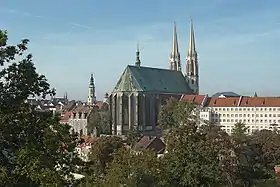 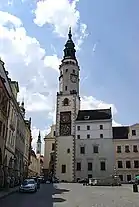 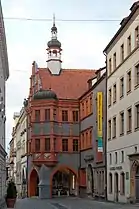   Clockwise from top: View over Görlitz, Schönhof, Upper Lusatian Library of Sciences (Oberlausitzische Bibliothek der Wissenschaften), renovated Gründerzeit buildings, Altes Rathaus (Old Town Hall) | |
 Flag  Coat of arms | |
Location of Görlitz within Görlitz district  | |
 Görlitz  Görlitz | |
| Coordinates: 51°09′10″N 14°59′14″E | |
| Country | Germany |
| State | Saxony |
| District | Görlitz |
| Subdivisions | 10 town- and 8 village-quarters |
| Government | |
| • Mayor | Octavian Ursu (CDU) |
| Area | |
| • Total | 67.22 km2 (25.95 sq mi) |
| Elevation | 199 m (653 ft) |
| Population (2019-12-31)[1] | |
| • Total | 55,980 |
| • Density | 830/km2 (2,200/sq mi) |
| Time zone | UTC+01:00 (CET) |
| • Summer (DST) | UTC+02:00 (CEST) |
| Postal codes | 02826–02828 |
| Dialling codes | 03581 |
| Vehicle registration | GR |
| Website | www |
The town's recorded history began in the 11th century as a Sorbian settlement. Throughout its history, it was under German, Czech (Bohemian), Polish and Hungarian rule. From 1815 until 1918, Görlitz belonged to the Province of Silesia in the Kingdom of Prussia, and later to the Province of Lower Silesia in the Free State of Prussia. It is the largest town of the former Province of Lower Silesia that lies west of the Oder-Neisse line and hence formed part of East Germany after World War II. Today within Germany, Görlitz lies opposite the Polish town of Zgorzelec, which was part of Görlitz until 1945. Together they form the German-Polish Euro City of Görlitz-Zgorzelec.
Görlitz combines Lusatian and Silesian traditions as well as German and Sorbian culture. Spared from the destruction of World War II, the town also has a rich architectural heritage. Many movie-makers have used the various sites as filming locations.[2]
History
Middle Ages
As a small Sorbian village named Gorelic in the Margraviate of Meissen, a frontier march of the Holy Roman Empire, it was conquered by Polish ruler Bolesław I Chrobry in 1002, and then formed part of the Duchy of Poland (kingdom from 1025) until 1031, when the region fell back to the Margraviate of Meissen. In 1075, the village was assigned to the Duchy of Bohemia. The date of the town's foundation is unknown. However, Goreliz was first mentioned in a document from the King of Germany, and later Holy Roman Emperor, Henry IV in 1071. This document granted Görlitz to the Diocese of Meissen, then under Bishop Benno of Meissen. Currently, this document can be found in the Saxony State Archives in Dresden.[3] The origin of the name Görlitz is derived from the Slavic word for "burned land",[4] referring to the technique used to clear land for settlement. Zgorzelec and Czech Zhořelec have the same derivation. In 1126–1131, Bohemian Duke Soběslav I erected a castle, one of several new castles on the Bohemian-Polish border. It was probably located at the site of the present St. Peter and Paul church. In the 13th century the village gradually became a town. Due to its location on the Via Regia, an ancient and medieval trade route, the settlement prospered.
In 1319 it became part of the Piast-ruled Duchy of Jawor, the southwesternmost duchy of fragmented Poland, and Duke Henry I of Jawor confirmed the town's privileges.[5] Later on, the town fell back to Bohemia. From 1346 Görlitz was a wealthy member of the Lusatian League, which consisted of Bautzen, Görlitz, Kamenz, Lubań, Löbau and Zittau. In 1352 during the reign of King Casimir III the Great, Lusatian German colonists from Görlitz founded the town of Gorlice in southern Poland near Kraków. In 1469, along with the Lusatian League, the town recognized the rule of King Matthias Corvinus, thus passing to Hungarian rule, and in 1490 it fell back to Bohemia then ruled by Polish prince Vladislaus Jagiellon.[6]
Modern period
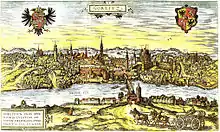
The Protestant Reformation came to Görlitz in the early 1520s and by the last half of the 16th century, it and the surrounding vicinity, became almost completely Lutheran.
After suffering for years in the Thirty Years' War, the region of Upper Lusatia (including Görlitz) was ceded to the Electorate of Saxony in 1635, from 1697 within the Polish–Saxon personal union. One of two main routes connecting Warsaw and Dresden ran through the town in the 18th century and Kings Augustus II the Strong and Augustus III of Poland often traveled that route.[7] Napoleon visited the town several times in 1807, 1812 and 1813. After the Napoleonic Wars, the 1815 Congress of Vienna transferred the town from the Kingdom of Saxony to the Kingdom of Prussia. Görlitz was subsequently administered within the Province of Silesia, and, after World War I, the Province of Lower Silesia, until 1945. During World War I, an internment camp for Greek soldiers was located in present-day Zgorzelec, while 500 Greek officers lived in private quarters throughout the town.[8] A burial ground for Greek soldiers was located at the local cemetery.[8]
Interbellum and World War II
Shortly after the Nazi Party's rise to power, in March 1933, the SA established the Leschwitz concentration camp in Leschwitz (present-day Weinhübel).[9] Political prisoners were held and tortured in the camp, before it was dissolved in August 1933, and the prisoners were deported to other Nazi concentration camps.[9] In 1936, during a nationwide Nazi campaign of changing of placenames, two present-day districts of Görlitz were renamed to erase traces of Slavic origin—Leschwitz to Weinhübel and Nikrisch to Hagenwerder—and the historic names were not restored since.[10][11]During Kristallnacht in November 1938, an arson attack was carried out on the city's synagogue. However, the building survived the attack without major damage, because courageous firefighters resisted the order not to extinguish the fire.[12]

During World War II, a Nazi prison was operated in the town, with four forced labour subcamps within the town limits and three in nearby villages.[13] The Nazis also established and operated two subcamps of the Gross-Rosen concentration camp, located in present-day districts of Biesnitz and Kunnerwitz, in which over 1,500 Jewish men and women were used as forced labour, and 470 of whom died.[14] The prisoner-of-war camp known as Stalag VIII-A was situated in the town of Görlitz, so its location is referred to as such. However, its location was east of the river, so it now lies in the Polish town of Zgorzelec (see below).[15][16] Numerous subcamps of Stalag VIII-A were located in the town, in which over 10,000 POWs worked as forced labour in 1942, and one of the largest subcamps was located in nearby Weinhübel (district of Görlitz since 1949).[17] After the Soviet offensive of 1944 and the partial evacuation of the German court staff from the General Government in German-occupied Poland, a special court of the General Government was established at the local courthouse.[18] Several Polish citizens were detained in Görlitz and sentenced to prison or death at this court for rescuing Jews.[19]
Near the end of World War II, German troops destroyed all bridges crossing the Lusatian Neisse. The redrawing of boundaries in 1945—in particular the location of the East German-Polish border to the present Oder-Neisse line—divided the town. The right bank became again part of Poland and was initially renamed Zgorzelice, and then Zgorzelec in 1948, with both names being historically used in the Polish language, while the main portion on the left bank became part of East Germany, now within the state of Saxony.

Recent history
When the East German states were dissolved in 1952, Görlitz became part of the Dresden District, but the states were restored upon German reunification in 1990. In 1972, the East German-Polish border was opened for visa-free travel, resulting in intense movement between Görlitz and Zgorzelec, which lasted until 1980, when East Germany unilaterally closed the border due to anti-communist protests and the emergence of the Solidarity movement in Poland. On 27 June 1994, the town became the seat of the Roman Catholic Diocese of Görlitz, but it remains a Lutheran Protestant stronghold.
In 2002 Lake Berzdorf, located south of Görlitz, began to flood. The Altstadtbrücke (literally old town bridge) between Görlitz and sister city Zgorzelec was rebuilt between 2003 and 2004. It was officially opened on 20 October 2004. As soon as Poland signed the Schengen Agreement (20 December 2007), movement between the two banks of the river again became unrestricted, since border controls were eliminated. Indeed, users of the new pedestrian bridge are not told by any signs that they are leaving one country and entering another.
Whilst the town was well preserved, it was notably grey and colourless under communist East German rule. Since reunification, and as of 2013, over 700 buildings have been renovated. It is a popular place for retirement among the elderly of Germany, being quiet and relatively affordable by German standards.[20] Its tourist potential is rapidly expanding, being very much an eastern counterpart to towns such as Heidelberg. In the case of Görlitz, much of the funding for the renovations of the towns buildings comes from an anonymous donor, who, from 1995 onward, has sent an annual donation of over €500,000, totalling over €10,000,000.[21]
Arts and culture
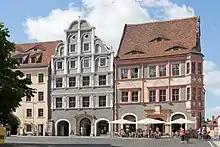
_01(js).jpg.webp)
Today Görlitz and Zgorzelec, two towns on opposite banks of the narrow river, get along well. Two bridges have been rebuilt, a bus line connects the German and Polish parts of the town, and there is a common urban management, with annual joint sessions of both town councils.
The town has a rich architectural heritage (Gothic, Renaissance, Baroque, Neoclassical, Art Nouveau). One example of this rich architectural heritage is the Schönhof, which is one of the oldest civic Renaissance buildings in Germany. Another medieval heritage is a model of the Holy Sepulchre (de) which was constructed in the late 15th century.
In 2006 the twin city Görlitz/Zgorzelec applied to be the European City of Culture 2010. It was hoped that the concept of Polish-German cooperation would be sufficient to convince the jury, but Essen won. Görlitz was placed second. As a result of the campaign Görlitz was renamed City of Culture in order to further German-Polish relations and to attract tourists from all over the world.[22]
As Görlitz was part of Silesia from 1815 onward, it has a Silesian Museum dedicated to the region (Schlesisches Museum zu Görlitz). The exhibition features the 1000-year-old cultural history of Silesia.
Görlitz is also the birthplace of the German version of nonpareils, popularly known in Germany as Liebesperlen (German: love pearls). Invented by confectioner Rudolf Hoinkis (1876–1944), the name derives from a conversation Hoinkis had with his wife, proclaiming his love for her like these "pearls", the nonpareil. Unsure of what to call the treat he invented, his wife suggested calling them love pearls, and the name stuck. The factory where he first manufactured the treat, founded in 1896, is now run by his great-grandson, Mathias.[23]
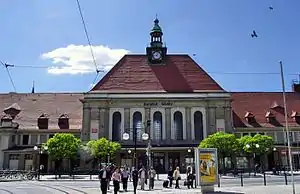
Transport
Görlitz station is on the Berlin – Görlitz and the Dresden – Görlitz lines of Deutsche Bahn. The station also provides an international connection to Wrocław, Poland.
Local public transport is provided by:
- The Verkehrsgesellschaft Görlitz (VGG) provides public transport service in the city, including the Görlitz tramway and bus services.[24]
- The Przedsiębiorstwo Komunikacji Samochodowej (PKS) provides bus service over the river between Görlitz and its sister city, Zgorzelec.[25]
Film location
Due to the historical parts of the city, many movie-makers have used the various sites as locations. Eli Roth shot the movie-in-a-movie Stolz der Nation (Pride of the Nation) for Quentin Tarantino's Inglourious Basterds (which incidentally purports to be France) on the Untermarkt and Obermarkt in Görlitz' oldest parts of the city.[26][27] Other films shot in Görlitz include the 2013 war drama The Book Thief and the teen years in The Reader. Görlitz was used as the primary shooting location for the Wes Anderson film The Grand Budapest Hotel, with Görlitz standing in for a resort in the fictional Eastern European country of Zubrowka. A vacant department store in the city was redecorated to serve as the hotel itself.[28]
Governance
Mayor and city council
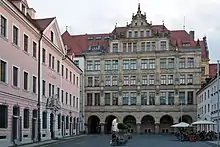
The first freely elected mayor after German reunification was Matthias Lechner of the Christian Democratic Union (CDU), who served from 1990 to 1998. The mayor was originally chosen by the city council, but since 1994 has been directly elected. Rolf Karbaum served from 1998 until 2005, Joachim Paulick from 2005 to 2012, and Siegfried Deinege from 2012 to 2019; all were independents. In 2019, CDU politician Octavian Ursu was elected mayor. The most recent mayoral election was held on 26 May 2019, with a runoff held on 16 June, and the results were as follows:
| Candidate | Party | First round | Second round | |||
|---|---|---|---|---|---|---|
| Votes | % | Votes | % | |||
| Sebastian Wippel | Alternative for Germany | 9,710 | 36.4 | 11,390 | 44.8 | |
| Octavian Ursu | Christian Democratic Union | 8,077 | 30.3 | 14,043 | 55.2 | |
| Franziska Schubert | Green / BfG / MG / SPD / PARTEI | 7,436 | 27.9 | |||
| Jana Lübeck | The Left | 1,470 | 5.5 | |||
| Valid votes | 26,693 | 98.7 | 25,433 | 98.6 | ||
| Invalid votes | 339 | 1.3 | 370 | 1.4 | ||
| Total | 27,032 | 100.0 | 25,803 | 100.0 | ||
| Electorate/voter turnout | 46,120 | 58.6 | 46,135 | 55.9 | ||
| Source: Wahlen in Sachsen | ||||||
The most recent city council election was held on 26 May 2019, and the results were as follows:
| Party | Votes | % | +/- | Seats | +/- | |
|---|---|---|---|---|---|---|
| Alternative for Germany (AfD) | 23,603 | 30.7 | New | 13 | New | |
| Christian Democratic Union (CDU) | 16,896 | 22.0 | 9 | |||
| Citizens for Görlitz (BfG) | 13,397 | 17.5 | 8 | |||
| The Left (Die Linke) | 6,516 | 8.5 | 3 | |||
| Alliance 90/The Greens (Grüne) | 5,847 | 7.6 | 2 | |||
| Motor Görlitz (MG) | 4,347 | 5.7 | New | 2 | New | |
| Social Democratic Party (SPD) | 1,782 | 2.3 | 1 | |||
| Down to Business! (ZS) | 1,729 | 2.3 | 0 | |||
| Free Democratic Party (FDP) | 1,663 | 2.2 | 0 | |||
| BI Seensucht | 604 | 0.8 | New | 0 | New | |
| National Democratic Party (NPD) | 376 | 0.5 | 0 | |||
| Valid votes | 26,530 | 98.0 | ||||
| Invalid votes | 544 | 2.0 | ||||
| Total | 27,074 | 100.0 | 42 | ±0 | ||
| Electorate/voter turnout | 46,119 | 58.7 | ||||
| Source: Wahlen in Sachsen | ||||||
Twin towns – sister cities
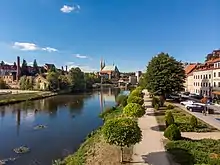
 Amiens, France
Amiens, France Molfetta, Italy
Molfetta, Italy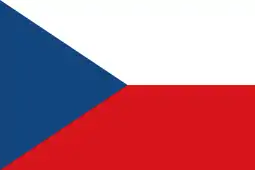 Nový Jičín, Czech Republic
Nový Jičín, Czech Republic Wiesbaden, Germany
Wiesbaden, Germany Zgorzelec, Poland
Zgorzelec, Poland
Being the easternmost town in the country, Görlitz has formed a "Compass Alliance" (Zipfelbund) with the northernmost, westernmost, and southernmost towns, List, Selfkant, and Oberstdorf respectively. They participate in the annual German Unity Day celebrations to represent the modern limits of Germany.[30]
Notable people

- Michael Ballack (born 1976), football player
- Jakob Böhme (1575–1624), mystic and theologian
- Johann Christoph Brotze (1742–1823), educator
- Hans Georg Dehmelt (1922–2017), co-recipient of 1989 Nobel Prize in Physics
- Hans-Jürgen Dörner (born 1951), football player and coach
- Werner Finck (1902–1978), comedian, actor and writer
- Richard Foerster (classical scholar) (1843–1922), classical scholar
- Johann Carl Gehler (1732–1796) physician, anatomist and mineralogist
- Johann Gottlob Harrer (1703–1755), composer
- Torsten Gütschow (born 1962), football player
- Herbert Hirche (1910–2002), architect and designer
- Hanna von Hoerner (1942–2014), astrophysicist
- Emil Jannings (1884–1950), first actor to win the Academy Award for Best Actor
- Jens Jeremies (born 1974), football player
- Reinhart Koselleck (1923–2006), historian
- Michael Kretschmer (born 1975), politician (CDU)
- Lars Kaufmann (born 1982), handball player
- Olivier Messiaen (1908–1992), musician, interned at Stalag VIII-A
- Oskar Morgenstern (1902–1977), economist
- Gustavus Adolphus Neumann (1807–1886), publisher
- Arthur Pohl (1900–1970), set designer, director and screenwriter
- Pavle Jurišić Šturm (1848–1922), Serbian Army general, born in Görlitz
- Alfred Wagenknecht (1881–1956), American Marxist politician
- Giorgio Zur (1930–2019), Catholic Archbishop and Apostolic Nuncio in Austria
Climate
The climate is oceanic (Köppen: Cfb) or on the western edge of humid continental (Dfb) by the 0 °C isotherm. In other words, the climate is still greater but relevant influence of the continentality. Its location in the far east of Germany and further away from the sea gives a climate with lower performance of the west winds although still present until the western half of Poland. Summers can be warm, though not as much as the southern continent and the winters are cold and snowy, although it does not remain all winter.[31]
| Climate data for Görlitz, 1981–2010 normals | |||||||||||||
|---|---|---|---|---|---|---|---|---|---|---|---|---|---|
| Month | Jan | Feb | Mar | Apr | May | Jun | Jul | Aug | Sep | Oct | Nov | Dec | Year |
| Average high °C (°F) | 1.8 (35.2) |
3.1 (37.6) |
7.6 (45.7) |
13.5 (56.3) |
18.7 (65.7) |
21.2 (70.2) |
23.7 (74.7) |
23.4 (74.1) |
18.4 (65.1) |
13.1 (55.6) |
6.5 (43.7) |
2.6 (36.7) |
12.8 (55.1) |
| Average low °C (°F) | −3.2 (26.2) |
−2.6 (27.3) |
0.5 (32.9) |
3.7 (38.7) |
8.1 (46.6) |
11.1 (52.0) |
13.1 (55.6) |
12.8 (55.0) |
9.6 (49.3) |
5.7 (42.3) |
1.5 (34.7) |
−1.9 (28.6) |
4.9 (40.8) |
| Average rainfall mm (inches) | 45.7 (1.80) |
37.3 (1.47) |
49.2 (1.94) |
40.0 (1.57) |
57.6 (2.27) |
65.8 (2.59) |
86.6 (3.41) |
80.0 (3.15) |
53.4 (2.10) |
40.3 (1.59) |
49.2 (1.94) |
50.7 (2.00) |
655.8 (25.83) |
| Mean monthly sunshine hours | 62.8 | 78.8 | 120.9 | 179.2 | 223.6 | 210.5 | 228.2 | 220.3 | 152.7 | 124.9 | 62.9 | 50.1 | 1,714.9 |
| Source: Météoclimat | |||||||||||||
| Climate data for Görlitz (near the Goerlitz Airstrip), elevation: 238 m, 1961-1990 normals and extremes | |||||||||||||
|---|---|---|---|---|---|---|---|---|---|---|---|---|---|
| Month | Jan | Feb | Mar | Apr | May | Jun | Jul | Aug | Sep | Oct | Nov | Dec | Year |
| Record high °C (°F) | 14.3 (57.7) |
15.9 (60.6) |
22.5 (72.5) |
30.2 (86.4) |
30.0 (86.0) |
32.7 (90.9) |
35.7 (96.3) |
34.0 (93.2) |
32.1 (89.8) |
26.0 (78.8) |
18.4 (65.1) |
15.3 (59.5) |
35.7 (96.3) |
| Average high °C (°F) | 0.9 (33.6) |
2.7 (36.9) |
7.1 (44.8) |
12.6 (54.7) |
18.0 (64.4) |
21.2 (70.2) |
22.8 (73.0) |
22.6 (72.7) |
18.6 (65.5) |
13.3 (55.9) |
6.5 (43.7) |
2.5 (36.5) |
12.4 (54.3) |
| Daily mean °C (°F) | −1.5 (29.3) |
−0.4 (31.3) |
3.2 (37.8) |
7.6 (45.7) |
12.6 (54.7) |
15.8 (60.4) |
17.3 (63.1) |
16.9 (62.4) |
13.6 (56.5) |
9.2 (48.6) |
3.9 (39.0) |
0.2 (32.4) |
8.2 (46.8) |
| Average low °C (°F) | −4.0 (24.8) |
−3.1 (26.4) |
−0.1 (31.8) |
3.3 (37.9) |
7.6 (45.7) |
10.9 (51.6) |
12.4 (54.3) |
12.0 (53.6) |
9.5 (49.1) |
5.8 (42.4) |
1.5 (34.7) |
−2.1 (28.2) |
4.5 (40.0) |
| Record low °C (°F) | −27.5 (−17.5) |
−23.7 (−10.7) |
−18.2 (−0.8) |
−5.6 (21.9) |
−2.6 (27.3) |
0.2 (32.4) |
4.8 (40.6) |
4.1 (39.4) |
−0.4 (31.3) |
−5.0 (23.0) |
−14.7 (5.5) |
−21.0 (−5.8) |
−27.5 (−17.5) |
| Average precipitation mm (inches) | 47.0 (1.85) |
37.0 (1.46) |
38.0 (1.50) |
50.0 (1.97) |
66.0 (2.60) |
70.0 (2.76) |
70.0 (2.76) |
74.0 (2.91) |
52.0 (2.05) |
45.0 (1.77) |
51.0 (2.01) |
57.0 (2.24) |
657 (25.88) |
| Average precipitation days (≥ 1.0 mm) | 10.0 | 9.0 | 9.0 | 10.0 | 10.0 | 10.0 | 10.0 | 10.0 | 9.0 | 7.0 | 10.0 | 12.0 | 116 |
| Mean monthly sunshine hours | 55.8 | 76.0 | 120.8 | 157.5 | 213.8 | 210.5 | 221.7 | 209.7 | 153.6 | 126.8 | 57.9 | 45.1 | 1,649.2 |
| Source: NOAA[32] | |||||||||||||
Gallery
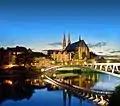 St. Peter and Paul church and the river Lusatian Neisse in Görlitz
St. Peter and Paul church and the river Lusatian Neisse in Görlitz Interior of St. Peter and Paul with its Sonnenorgel (sun organ)
Interior of St. Peter and Paul with its Sonnenorgel (sun organ) The Schönhof, the oldest Renaissance building in Görlitz
The Schönhof, the oldest Renaissance building in Görlitz Interior of the Görlitzer Warenhaus department store
Interior of the Görlitzer Warenhaus department store View over Obermarkt taken from Reichenbacher Turm, residential buildings of Zgorzelec in the background
View over Obermarkt taken from Reichenbacher Turm, residential buildings of Zgorzelec in the background Old town hall
Old town hall Royal coats of arms of Hungarian King Matthias Corvinus (Old Town Hall)
Royal coats of arms of Hungarian King Matthias Corvinus (Old Town Hall) Reichenbacher Turm
Reichenbacher Turm Courthouse
Courthouse The Landeskrone, literally "land's crown", the local mountain of Görlitz
The Landeskrone, literally "land's crown", the local mountain of Görlitz Theatre
Theatre Gothic Holy Trinity church
Gothic Holy Trinity church
See also
References
- "Bevölkerung des Freistaates Sachsen nach Gemeinden am 31. Dezember 2019". Statistisches Landesamt des Freistaates Sachsen (in German). July 2020.
- Heinz, Marlis. "Hier dreht sich alles um das Drehen". morgenpost.de. Retrieved 7 April 2017.
- "Deutschlands Städte, Gemeinden und Kreise online - FindCity". findcity.de. Archived from the original on 20 May 2007. Retrieved 7 April 2017.
- "Placenames of the World" by Adrian Room, McFarland Pub. 2003 page 140
- "Heinrich I., Herzog von Schlesien". Deutsche-Biographie.de (in German). Retrieved 31 October 2020.
- Gustav Köhler, Der Bund der Sechsstädte in der Ober-Lausitz: Eine Jubelschrift, G. Heinze & Comp., Görlitz, 1846, p. 30 (in German)
- "Informacja historyczna". Dresden-Warszawa (in Polish). Retrieved 31 October 2020.
- "Als Tausende Griechen in Görlitz Zuflucht suchten". LR Online (in German). Retrieved 12 December 2020.
- "Eine schlichte Tafel erinnert an das unermessliche Leid im KZ Leschwitz". saechsische.de (in German). Retrieved 31 October 2020.
- "Straßensperrung". Görlitzer Anzeiger (in German). Retrieved 12 December 2020.
- "Brücke in Hagenwerder wird komplett erneuert". Görlitzer Anzeiger (in German). Retrieved 31 October 2020.
- "Jugendstil ohne Juden". juedische-allgemeine.de (in German). Retrieved 21 November 2020.
- "Gefängnis Görlitz". Bundesarchiv.de (in German). Retrieved 31 October 2020.
- "Subcamps of KL Gross- Rosen". Gross-Rosen Museum in Rogoźnica. Retrieved 31 October 2020.
- "European Center Memory, Education, Culture". Meetingpoint Music Messiaen e.V. 17 April 2020. Retrieved 27 May 2020.
- "Stalag VIII A". Meetingpoint Music Messiaen e.V. 2 May 2019. Retrieved 27 May 2020.
- Joanna Lusek, Albrecht Goetze, Stalag VIII A Görlitz. Historia – teraźniejszość – przyszłość, "Łambinowicki rocznik muzealny" Tom 34, Opole, 2011, p. 42-43 (in Polish)
- Andrzej Wrzyszcz, Z badań nad ewakuacją organów resortu sprawiedliwości Generalnego Gubernatorstwa w latach 1944–1945, "Studia z dziejów państwa i prawa polskiego" Tom XI, Kraków, 2008, p. 270 (in Polish)
- Rejestr faktów represji na obywatelach polskich za pomoc ludności żydowskiej w okresie II wojny światowej, IPN, Warszawa, 2014, p. 68-69, 78, 81 (in Polish)
- "Warum Görlitz für ältere Menschen so attraktiv ist". goerlitzer-anzeiger.de. Görlitzer Anzeiger. 10 June 2019. Retrieved 3 May 2020.
- "Görlitz' Generous Donor". dw.com. Deutsche Welle. 23 April 2013. Retrieved 1 May 2017.
- "German Research Project Offers One Week of Free Living | DW | 14.09.2008". DW.COM a. Retrieved 18 April 2020.
- "Nonpareil - sweet treat from Görlitz". dw.com. Deutsche Welle. 28 April 2016. Archived from the original on 1 December 2017. Retrieved 1 May 2017.
- "Willkommen" (in German). Verkehrsgesellschaft Görlitz GmbH. Retrieved 20 February 2015.
- "Informacje bieżące" [Current Information] (in Polish). Polnische Verkehrsgesellschaft (Polish Transport Company). Archived from the original on 10 March 2012. Retrieved 23 June 2010.
- Duke, Alan (11 August 2009). "'Basterds' pro-Nazi short made by a Jewish director - CNN.com". CNN. Retrieved 7 April 2017.
- "'Newcomer Görlitz', das Stadtportrait für das MYSELF Magazin - Fotos Christian KERBER c/o SOLAR UND FOTOGRAFEN". Gosee (in German). 22 April 2016. Retrieved 7 April 2017.
- "Wes Anderson's new movie has a distributor, plot". The A.V. Club. 28 March 2013. Retrieved 7 April 2017.
- "Städtepartnerschaften". goerlitz.de (in German). Görlitz. Retrieved 3 February 2021.
- "Tag der Deutschen Einheit". zipfelbund.de (in German). Retrieved 30 April 2020.
- "Gorlitz, Germany Köppen Climate Classification (Weatherbase)". Weatherbase. Retrieved 1 February 2019.
- "Görlitz (10499) - WMO Weather Station". NOAA. Retrieved 31 January 2019.
External links
| Wikimedia Commons has media related to Görlitz. |
| Wikisource has the text of the 1911 Encyclopædia Britannica article Görlitz. |
 Görlitz travel guide from Wikivoyage
Görlitz travel guide from Wikivoyage- Official website (in English)
- Official website
 (in German)
(in German) - DW-World 'trial living' report.
- "Görlitz/Zgorzelec – Urban development from 12th to 21st century" on YouTube